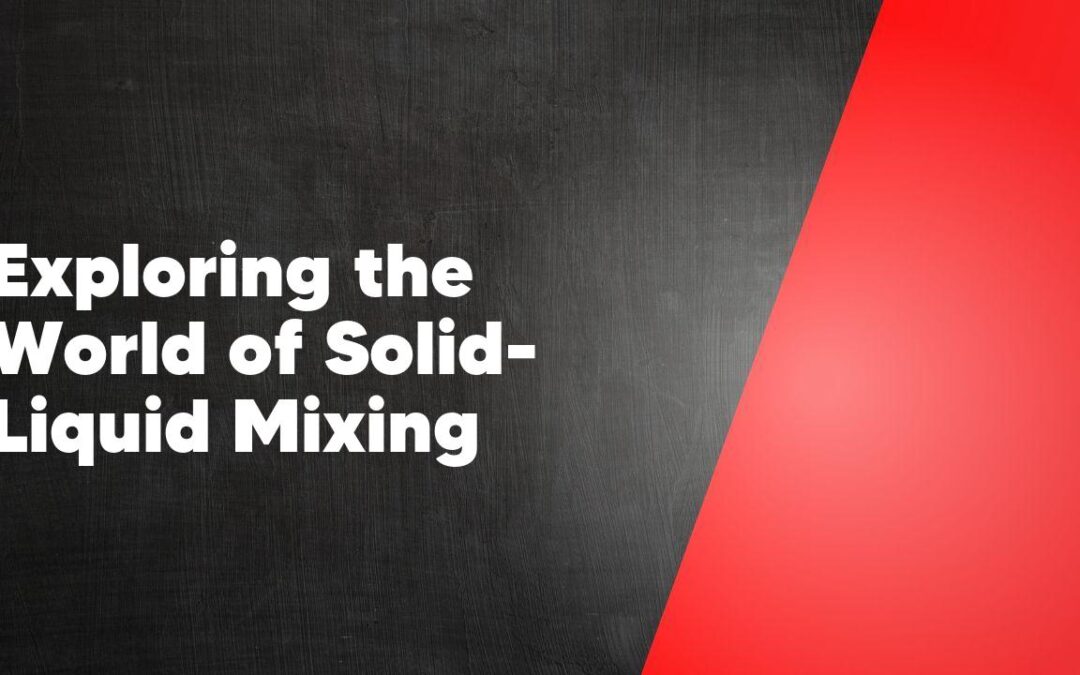This article delves into the fascinating world of solid-liquid mixing, a process that plays a crucial role in numerous industries. From pharmaceuticals to food production, understanding the dynamics and mechanics of this process is key to achieving optimal results. We will explore the different techniques and factors that affect solid-liquid mixing, as well as its applications and challenges.
1. Understanding the Basics: What is Solid-Liquid Mixing?
As someone who is new to the field of solid-liquid mixing, it is important to first understand the basics of this process. Solid-liquid mixing refers to the combination of a solid material with a liquid to create a homogeneous mixture. This process is crucial in various industries such as pharmaceuticals, food, and chemical manufacturing. The aim of solid-liquid mixing is to ensure proper dispersion of the solids within the liquid, resulting in a consistent and uniform product. It involves the selection of appropriate equipment and parameters such as mixing speed, time, and temperature. By understanding the fundamentals of solid-liquid mixing, one can effectively contribute to the efficient and quality production of various products.
2. Key Factors Influencing Solid-Liquid Mixing Performance

In my experience, there are two key factors that greatly influence solid-liquid mixing performance: the viscosity of the liquid and the size and density of the solid particles. The viscosity of the liquid determines how easily it flows and how well it can mix with the solid particles. A low viscosity liquid will have better mixing performance as it can easily flow around and disperse the solid particles. On the other hand, a high viscosity liquid will have poorer mixing performance as it tends to be more resistant to flowing and may result in clumping of the solid particles. Additionally, the size and density of the solid particles also play a significant role. Smaller particles tend to have better mixing performance as they provide a larger surface area for interaction with the liquid. Heavier and denser particles can also have a positive impact on the mixing process as they tend to sink downward and promote better dispersion. Overall, understanding and considering these factors is crucial in achieving efficient solid-liquid mixing.
3. Different Mixing Techniques for Solid-Liquid Systems
In this article, I will be discussing different mixing techniques for solid-liquid systems. When it comes to mixing solids and liquids together, it is important to achieve a homogeneous mixture for optimal results. One common method is mechanical agitation, where a mixing device such as a paddle or impeller is used to physically stir the mixture. Another technique is the use of an ultrasound probe, which applies high-frequency sound waves to disrupt the solids and promote mixing. Additionally, the use of high-pressure homogenizers can create intense shearing forces to break down solid particles and disperse them evenly throughout the liquid. Each of these techniques have their advantages and can be chosen based on the specific requirements of the solid-liquid system being mixed.
4. Common Challenges and Solutions in Solid-Liquid Mixing
As a female engineer in the field of solid-liquid mixing, I have encountered several typical challenges and found solutions to overcome them. One common issue I often come across is the formation of agglomerates during the mixing process. To tackle this, I have found that using a suitable dispersing agent or adjusting the mixing intensity can effectively break down agglomerates and improve the overall homogeneity of the mixture. Another challenge I have faced is the presence of air bubbles in the mixture, which can affect the process efficiency. To address this, I have learned to adjust the mixing speed or incorporate a degassing step to remove the trapped air. By being attentive to these challenges and implementing these solutions, I have been able to successfully navigate the complexities of solid-liquid mixing in my work as a female engineer.
5. Mixing Equipment: Choosing the Right Tools for Solid-Liquid Mixing
When it comes to solid-liquid mixing, selecting the right tools is crucial. As a professional in the chemical industry, I have learned the importance of using the proper mixing equipment to ensure optimal results. There are a variety of options to choose from, such as agitators, impellers, and mixers. Agitators are commonly used for low-viscosity materials, while impellers are best suited for higher-viscosity liquids. Mixers, on the other hand, are a versatile option that can handle a wide range of materials. Understanding the properties of the materials being mixed is essential in determining the most suitable mixing equipment. By carefully selecting the right tools, I can confidently achieve efficient and effective solid-liquid mixing processes.
6. Applications and Industries that Benefit from Solid-Liquid Mixing
As a woman working in the field of solid-liquid mixing, I am proud to play a role in various applications and industries that benefit from this process. One industry that greatly benefits from solid-liquid mixing is the pharmaceutical industry. The blending of powders and liquids is essential in the production of medications, ensuring that the active ingredients are evenly distributed throughout the final product. Another industry that heavily relies on solid-liquid mixing is the food and beverage industry. From mixing ingredients for sauces and dressings to creating smooth and consistent textures in ice cream and yogurt, solid-liquid mixing is indispensable in delivering high-quality and tasty products to consumers. Additionally, wastewater treatment is another area where solid-liquid mixing is crucial, enabling the efficient separation and removal of solid particles from water. In all these applications and more, solid-liquid mixing plays a vital role in achieving optimal product quality and process efficiency.
Conclusion
In conclusion, solid-liquid mixing plays a crucial role in numerous industries, including pharmaceuticals, food processing, and chemical engineering. Understanding the principles and techniques of this process is essential for optimizing production efficiency and ensuring product quality. By continuously researching and improving solid-liquid mixing methods, industries can continue to innovate and meet the evolving needs of their customers.
What is solid-liquid mixing?
Solid-liquid mixing is the process of combining a solid material with a liquid to form a homogeneous mixture.
Why is solid-liquid mixing important?
Solid-liquid mixing is important in various industries, such as pharmaceuticals, food and beverage, and chemicals. It is necessary for the production of products like medications, processed foods, and chemicals.
What are the benefits of solid-liquid mixing?
The benefits of solid-liquid mixing include improved product quality, increased efficiency in processes, enhanced mass transfer, and better control over the desired physical and chemical properties of the final product.
What are the common methods of solid-liquid mixing?
The common methods of solid-liquid mixing include mechanical agitation, such as stirring and blending, as well as high-shear mixing techniques like homogenization and fluidization.
What factors need to be considered in solid-liquid mixing?
Factors that need to be considered in solid-liquid mixing include the characteristics of the solid material, desired mixing intensity, vessel design, mixing time, and temperature control.
How can solid-liquid mixing be optimized?
Solid-liquid mixing can be optimized by selecting the appropriate mixing equipment, ensuring proper vessel geometry, using suitable impellers, controlling mixing speed and duration, and monitoring the process parameters closely.

